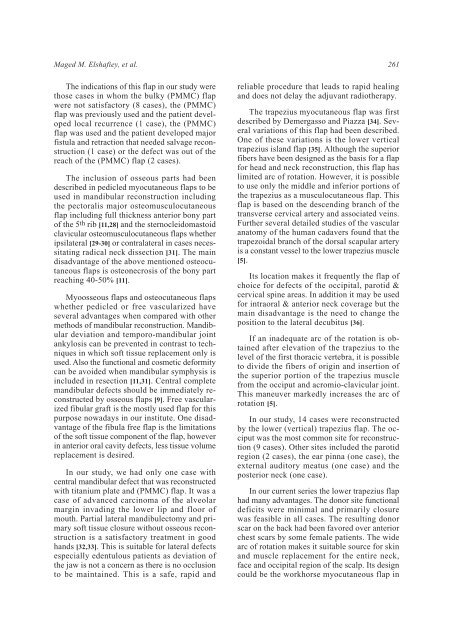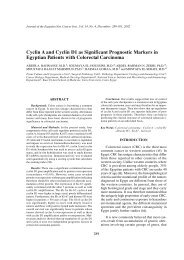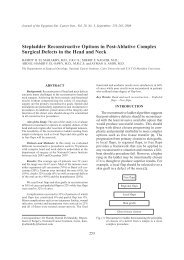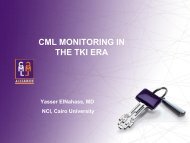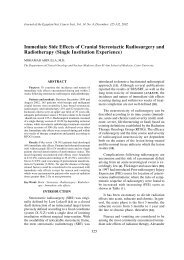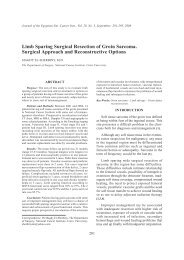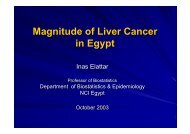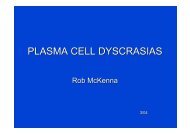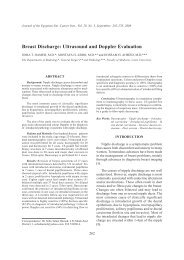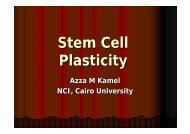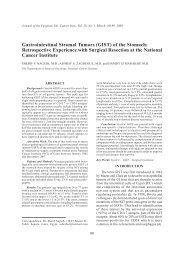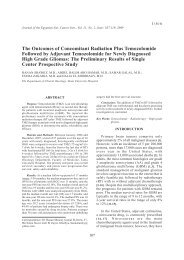Continuous Validity of Pedicled Myocutaneous and Myofascial ... - NCI
Continuous Validity of Pedicled Myocutaneous and Myofascial ... - NCI
Continuous Validity of Pedicled Myocutaneous and Myofascial ... - NCI
You also want an ePaper? Increase the reach of your titles
YUMPU automatically turns print PDFs into web optimized ePapers that Google loves.
Maged M. Elshafiey, et al. 261<br />
The indications <strong>of</strong> this flap in our study were<br />
those cases in whom the bulky (PMMC) flap<br />
were not satisfactory (8 cases), the (PMMC)<br />
flap was previously used <strong>and</strong> the patient developed<br />
local recurrence (1 case), the (PMMC)<br />
flap was used <strong>and</strong> the patient developed major<br />
fistula <strong>and</strong> retraction that needed salvage reconstruction<br />
(1 case) or the defect was out <strong>of</strong> the<br />
reach <strong>of</strong> the (PMMC) flap (2 cases).<br />
The inclusion <strong>of</strong> osseous parts had been<br />
described in pedicled myocutaneous flaps to be<br />
used in m<strong>and</strong>ibular reconstruction including<br />
the pectoralis major osteomusculocutaneous<br />
flap including full thickness anterior bony part<br />
<strong>of</strong> the 5 th rib [11,28] <strong>and</strong> the sternocleidomastoid<br />
clavicular osteomusculocutaneous flaps whether<br />
ipsilateral [29-30] or contralateral in cases necessitating<br />
radical neck dissection [31]. The main<br />
disadvantage <strong>of</strong> the above mentioned osteocutaneous<br />
flaps is osteonecrosis <strong>of</strong> the bony part<br />
reaching 40-50% [11].<br />
Myoosseous flaps <strong>and</strong> osteocutaneous flaps<br />
whether pedicled or free vascularized have<br />
several advantages when compared with other<br />
methods <strong>of</strong> m<strong>and</strong>ibular reconstruction. M<strong>and</strong>ibular<br />
deviation <strong>and</strong> temporo-m<strong>and</strong>ibular joint<br />
ankylosis can be prevented in contrast to techniques<br />
in which s<strong>of</strong>t tissue replacement only is<br />
used. Also the functional <strong>and</strong> cosmetic deformity<br />
can be avoided when m<strong>and</strong>ibular symphysis is<br />
included in resection [11,31]. Central complete<br />
m<strong>and</strong>ibular defects should be immediately reconstructed<br />
by osseous flaps [9]. Free vascularized<br />
fibular graft is the mostly used flap for this<br />
purpose nowadays in our institute. One disadvantage<br />
<strong>of</strong> the fibula free flap is the limitations<br />
<strong>of</strong> the s<strong>of</strong>t tissue component <strong>of</strong> the flap, however<br />
in anterior oral cavity defects, less tissue volume<br />
replacement is desired.<br />
In our study, we had only one case with<br />
central m<strong>and</strong>ibular defect that was reconstructed<br />
with titanium plate <strong>and</strong> (PMMC) flap. It was a<br />
case <strong>of</strong> advanced carcinoma <strong>of</strong> the alveolar<br />
margin invading the lower lip <strong>and</strong> floor <strong>of</strong><br />
mouth. Partial lateral m<strong>and</strong>ibulectomy <strong>and</strong> primary<br />
s<strong>of</strong>t tissue closure without osseous reconstruction<br />
is a satisfactory treatment in good<br />
h<strong>and</strong>s [32,33]. This is suitable for lateral defects<br />
especially edentulous patients as deviation <strong>of</strong><br />
the jaw is not a concern as there is no occlusion<br />
to be maintained. This is a safe, rapid <strong>and</strong><br />
reliable procedure that leads to rapid healing<br />
<strong>and</strong> does not delay the adjuvant radiotherapy.<br />
The trapezius myocutaneous flap was first<br />
described by Demergasso <strong>and</strong> Piazza [34]. Several<br />
variations <strong>of</strong> this flap had been described.<br />
One <strong>of</strong> these variations is the lower vertical<br />
trapezius isl<strong>and</strong> flap [35]. Although the superior<br />
fibers have been designed as the basis for a flap<br />
for head <strong>and</strong> neck reconstruction, this flap has<br />
limited arc <strong>of</strong> rotation. However, it is possible<br />
to use only the middle <strong>and</strong> inferior portions <strong>of</strong><br />
the trapezius as a musculocutaneous flap. This<br />
flap is based on the descending branch <strong>of</strong> the<br />
transverse cervical artery <strong>and</strong> associated veins.<br />
Further several detailed studies <strong>of</strong> the vascular<br />
anatomy <strong>of</strong> the human cadavers found that the<br />
trapezoidal branch <strong>of</strong> the dorsal scapular artery<br />
is a constant vessel to the lower trapezius muscle<br />
[5].<br />
Its location makes it frequently the flap <strong>of</strong><br />
choice for defects <strong>of</strong> the occipital, parotid &<br />
cervical spine areas. In addition it may be used<br />
for intraoral & anterior neck coverage but the<br />
main disadvantage is the need to change the<br />
position to the lateral decubitus [36].<br />
If an inadequate arc <strong>of</strong> the rotation is obtained<br />
after elevation <strong>of</strong> the trapezius to the<br />
level <strong>of</strong> the first thoracic vertebra, it is possible<br />
to divide the fibers <strong>of</strong> origin <strong>and</strong> insertion <strong>of</strong><br />
the superior portion <strong>of</strong> the trapezius muscle<br />
from the occiput <strong>and</strong> acromio-clavicular joint.<br />
This maneuver markedly increases the arc <strong>of</strong><br />
rotation [5].<br />
In our study, 14 cases were reconstructed<br />
by the lower (vertical) trapezius flap. The occiput<br />
was the most common site for reconstruction<br />
(9 cases). Other sites included the parotid<br />
region (2 cases), the ear pinna (one case), the<br />
external auditory meatus (one case) <strong>and</strong> the<br />
posterior neck (one case).<br />
In our current series the lower trapezius flap<br />
had many advantages. The donor site functional<br />
deficits were minimal <strong>and</strong> primarily closure<br />
was feasible in all cases. The resulting donor<br />
scar on the back had been favored over anterior<br />
chest scars by some female patients. The wide<br />
arc <strong>of</strong> rotation makes it suitable source for skin<br />
<strong>and</strong> muscle replacement for the entire neck,<br />
face <strong>and</strong> occipital region <strong>of</strong> the scalp. Its design<br />
could be the workhorse myocutaneous flap in


